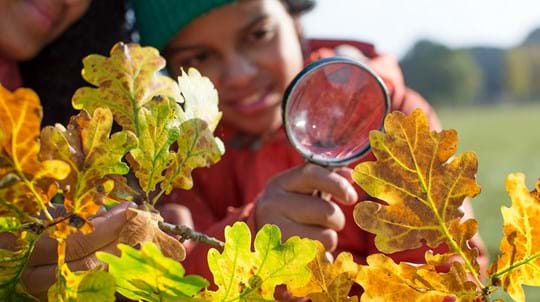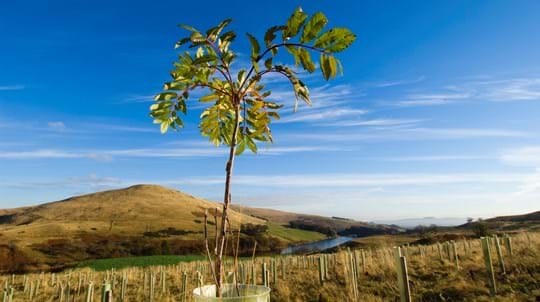
Credit: David Nash / WTML
Leaves
Triangular in shape but more rounded at the base than silver birch leaves. Leaf stalks are downy, as opposed to hairless on silver birch.
Soft on the outside. Tough on the inside. On a global scale, this tree, with its fuzzy leaf stalks, shoots and twigs, grows further north than any other broadleaf species.
Common name: downy birch, hairy birch, moor birch, white birch, common white birch, European white birch
Scientific name: Betula pubescens
Family: Betulaceae
Origin: native
Mature trees can reach 30m in height, forming a light canopy with elegant, drooping branches. Downy birch is more upright than silver birch and the bark is browner in colour with more obvious horizontal grooves and lacking the papery quality of the silver birch.
Look out for: bark which is grey-white, and triangular-shaped leaves.
Identified in winter by: bark which is white all year round and twigs that are softly hairy to the touch.

Credit: David Nash / WTML
Triangular in shape but more rounded at the base than silver birch leaves. Leaf stalks are downy, as opposed to hairless on silver birch.

Credit: David Nash / WTML
Downy birch is monoecious, meaning both male and female flowers (catkins) are found on the same tree. Appearing from April to May, male catkins are long and yellow-brown in colour. They hang in groups of two to four at the tips of shoots, like lambs' tails; while female catkins are smaller, short, bright green and erect.

Credit: FloralImages / Alamy Stock Photo
After successful pollination (by wind), female catkins thicken and change colour to a dark crimson. Masses of tiny seeds are borne in autumn and dispersed by the wind.
Silver birch (Betula pendula) and the two easily hybridise. Silver birch has hairless and warty shoots whereas downy birch shoots are covered in small, downy hairs. The bark of downy birch isn’t as white and papery as silver birch.

Download our free Tree ID app for Android and iPhone to identify the UK's native and non-native trees. It's an A-Z tree guide in your pocket.
Download the appFound throughout Europe, downy birch tends to grow on damper soils than silver birch and can even tolerate peat bogs and clay.
Its range is more northerly and western than silver birch, and it can grow at higher elevations. Around the world, it can grow further north than any other broadleaf species.
Birch woods (which may include downy or silver birch, or both) have a light, open canopy, providing the perfect conditions for grasses, mosses, wood anemones, bluebells, wood sorrel and violets to grow.
Downy birch provides food and habitat for more than 300 insect species. The leaves attract aphids, providing food for ladybirds and other species further up the food chain. They are also a food plant for the caterpillars of many moths, including the angle-shades, buff tip, pebble hook-tip, and Kentish glory. Birch trees are particularly associated with specific fungi, including fly agaric, woolly milk cap, birch milk cap, birch brittlegill, birch knight, chanterelle and the birch polypore (razor strop).
Woodpeckers and other hole-nesting birds often nest in the trunk, while the seeds are eaten by siskins, greenfinches and redpolls.
In early Celtic mythology, the birch symbolised renewal and purification. Bundles of birch twigs were used to drive out the spirits of the old year, and gardeners still use the birch besom, or broom, to 'purify' their gardens. It is also used as a symbol of love and fertility. In Scottish Highland folklore, a barren cow herded with a birch stick would become fertile, and a pregnant cow would bear a healthy calf.
In times of famine, the inner bark was ground up and used in bread-making.
Birch wood is tough and heavy, making it suitable for furniture, handles and toys. It was used to make bobbins, spools and reels for the Lancashire cotton industry; and herbal medicines were made from different parts of the tree. In spring, the rising sap can be used to make refreshing drinks, wines, ales and liqueurs; while the bark is used for tanning leather.
Planted birch appears to be susceptible to birch dieback, which is caused by two fungal pathogens, Marssonina betulae and Anisogramma virgultorum. Naturally regenerated birch (that grow from seeds fallen from trees) appears to be less prone to this disease.

Take part in our Nature's Calendar survey
Tell us what's happening to the trees around you and help scientists track the effects of climate change on wildlife.
External link

Shop
We have single trees and tree packs to meet your needs, from wildlife to woodfuel. Delivery is free.
External link